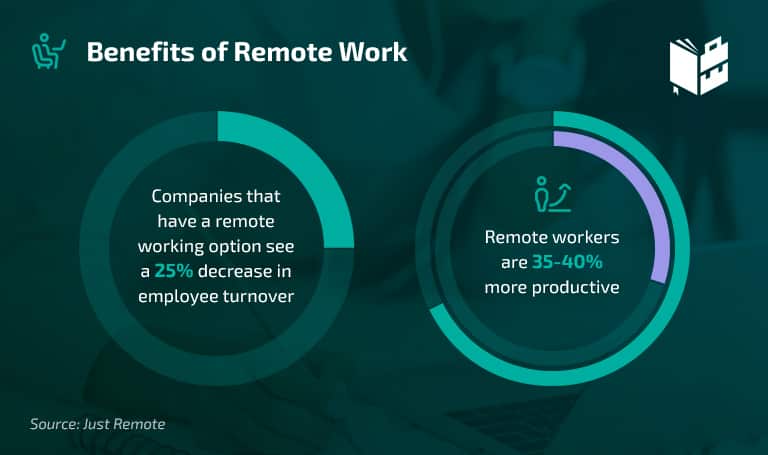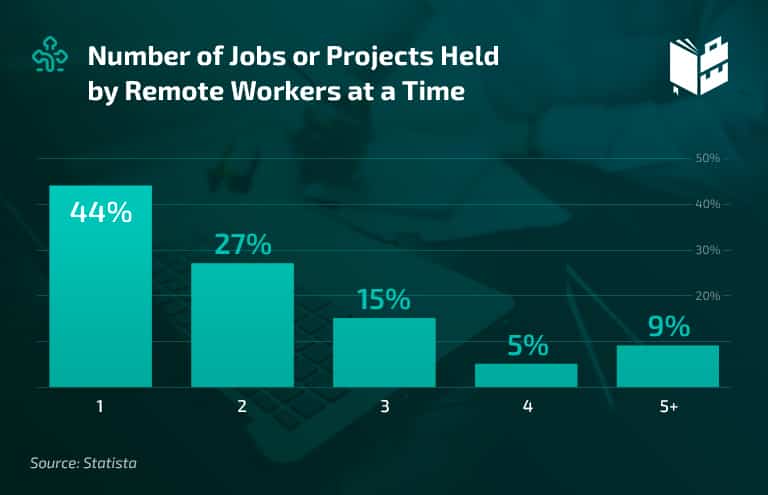Many remote work statistics show that working from home or outside a business’s main office has become a new business norm. Rising costs have led companies to find innovative solutions for reducing overheads.
Not having to maintain a business office for staff is a simple way to cut costs without affecting service too much, and employees enjoy the benefits of remote working.
These stats will give you a clear insight into remote work: its pros and cons, rates, prevalence, etc.
Most Relevant Telecommuting Statistics (Editor’s Choice)
- Remote work option in a company leads to a 25% decrease in employee turnover
- 37% of organizations don’t know how to deal with remote processes
- For 53% of US employees, flexible scheduling is the most significant benefit of remote working
- 98% of workers would work remotely for the rest of their careers
- 51% of remote workers have problems with isolation
- 32% of remote workers are offered vacation time
- Over 80% of employers plan to let workers work remotely even after the pandemic
- One in two people won’t return to the office after the pandemic
Remote Working Statistics For 2023 — What You Need to Know
Thanks to technological advancement, working remotely has been present even before 2021. However, the coronavirus pandemic has changed working trends, and nowadays, people work remotely more than ever before. Let’s take a look at some statistics about remote work in 2021.
74% of law firm respondents have started using video meeting apps only after the coronavirus pandemic announcement.
Even if 94% of survey respondents stated they’ve been using video meeting apps during the pandemic, most of them didn’t have any reason to use them before the coronavirus outbreak.
Working from home statistics for 2021 and its impact show that the adoption of technology in legal services has been accelerated.
There has been a 159% increase in remote workers over the last 12 years.
It’s important to note that the mentioned percentage doesn’t include freelancers or self-employed people. Companies that have changed over to working remotely employ these workers and maintain a remote workforce.
What’s even more interesting, the growth of remote workers during the last two years has increased by a shocking 68%.
66% of remote work employees check their emails during work.
It’s astonishing that an average employee wastes 1,400 working hours per year, according to the latest data. 64% of survey respondents say they perform other personal activities like reading the news, while 59% of remote workers do online shopping while they’re supposed to be working.
Companies that have a remote working option see a 25% decrease in employee turnover.
Apart from employee retention, companies can accumulate even more profit with a remote workforce, as they’re 35% to 40% more productive than in-house employees. Remote workers face distractions, but they can do more in the same amount of time.

5.2% of employees in the US currently work from home.
Working from home statistics from 2020 reveal that around eight million people in the US work from home. Furthermore, that number seems to increase every year, which is good since working from home has proven to be less stressful.
69% of remote workers experience burnout symptoms.
Even if remote employees in normal conditions experience less stress and burnout, we must consider that, to maintain excellent results, organizations have to give tasks to their remote employees more than ever before.
As many stats on remote work regarding the covid show, there has been a 20% increase in burnout rates since May 2020.
37% of organizations don’t know how to manage remote processes.
Many companies find it challenging to manage their remote workers, as they didn’t have to do it before the pandemic. They lack the experience and technology to face workflow challenges.
The more successful organizations have a person who manages internal remote work processes.
84% of companies are pushed to accelerate digitalization.
Covid remote work statistics show that, even though the global pandemic has had some detrimental effects, one of the few good things it showed is digitalization and automation.
Namely, 50% of companies have had to speed up automation which is pressuring but suitable for technological development.
Remote work saves an employee approximately 40 minutes per day.
Working remotely saves a lot of time and energy that would be spent commuting. That is one of the primary reasons remote employees are more productive: they have more time for themselves, and they don’t have to dress up for work and travel. They can invest that time in learning a new language, for example.
Remote Working Statistics — What Employees Say about Remote Work
The opinions about remote work are divided. Some employees can’t imagine a life without in-house work, while many remote workers state how much they enjoy the ability to maintain their work-life balance successfully. What’s a better option? Here are some statistics about employees and their opinions about working remotely.
70% of the US gig economy workers feel that work-life balance is an essential factor when choosing a job.
According to Statista’s telecommuting statistics, many workers found that working remotely can help establish their work/life balance.
Because of the more flexible schedule, employees can choose when they want to be available for work or rest. Namely, 87% of Americans said remote working improved their work-life balance.
53% of US employees state that flexible scheduling is the most significant benefit of remote working.
A flexible work schedule is one of the most important reasons people sign up for this kind of work environment. Remote working trends are the same in Canada, Australia, and The UK: 50% of employees or more rate flexible scheduling as the most significant advantage of remote work.
No commuting is one of the top benefits of remote work as of April 2020.
It’s hard to say which advantage of remote work is better, flexibility or no commuting. Statistics show that 47% of US employees state that not having to commute is one of the greatest benefits of remote work, as remote workers statistics show.
98% of workers would like to work remotely part- or full-time for the rest of their careers.
Remote workers agree that the benefits of working remotely far outweigh the potential downsides. Most remote workers would choose to continue to work from home. In addition, 97% of remote workers recommend it to others.
Telecommuting Trends — Pros and Cons of Remote Work
While there are some general pros and cons of remote work, we must consider that not every job can be done effectively from a remote position. Therefore, there are many advantages and some drawbacks of remote work both for employees and organizations.
40% of remote workers find it hard to disconnect after work.
A flexible schedule is a benefit but can be bad for some employees. Facts on remote work based on a survey point out that many remote employees find it difficult to disconnect from work.
Furthermore, 32% of them have to deal with distractions, while 21% face various technical problems in a remote workplace.
51% of remote workers struggle with isolation.
Workplace relationships play an essential role in creating a great work environment. That’s why working remotely from home can be difficult. Remote workers have far less contact with their coworkers and might battle with isolation. Managers struggle the most, along with senior vice presidents (45%).
5% of remote workers work on four different projects or jobs at a time.
Telecommuting productivity statistics point out that remote employees tend to work on multiple projects at the same time. Employees are changing the way they look at their careers.
By working from home, they can maximize your workday and fit in extra jobs much more easily.

20% of remote workers struggle with collaboration or communication.
A flexible work structure has definite benefits, but it can make it harder to find time to collaborate with your coworkers.
The coworker might not be available when the other one needs his help or advice, and vice versa, because work-from-home trends usually include working with people from different parts of the world.
70% of companies don’t cover the expenses of their remote employees’ remote work-related costs.
One of the primary benefits for a company operating in this space is that it saves on overhead. Many remote workers are expected to provide their own devices, pay for their home office equipment, internet and cell phone bills, space memberships, etc.
66% of remote employees work at night or during weekends.
Working from home stats highlight the importance of organization and establishing a healthy work-life balance (49% of remote workers find it hard to separate their work and home life). Setting a strict working schedule can prevent remote employees from working at night.
83% of employees with mental or physical disabilities can work due to a remote working option.
According to one of the newest remote work surveys, 14% of remote workers have chronic illnesses or other kinds of disabilities. Many telecommuting facts indicate that 83% of them wouldn’t be able to work if they haven’t had a remote working option.
32% of remote workers have unlimited vacation time.
Working flexitime makes it easier for the employer and employee to coordinate time schedules and allow more time off. However, even if they have unlimited vacation time, employees mostly don’t use it.
22% of workers took a three-week vacation within the last year.
Most remote workers took a three-week vacation last year. Work at home career trends show that a two-week vacation was the second-most popular option, as 21% of employees took it.
Only 6% of employees took no leave at all, while the other 6% took a six-week vacation. Remote work provides flexibility, even when time-off is in question.
53.3% of developers consider remote working a top priority.
Remote developers have shown considerably higher job satisfaction rates, as remote work is motivating, good for the environment (due to less commuting), and saves a lot of money.
Global Remote Work Statistics — The Future Predictions
Times and working trends change, and this year has shown for sudden that changes can be. What about the future of global remote working? We can’t certainly know what will happen with a remote workforce, but we can always lean on the statistics. Let’s see what they can tell us about the future of remote work.
By 2027, 50.9% of the US workforce will be freelancers.
That’s about 86.9 million Americans working remotely. It’s a sign of the times—we’re no longer chained to our desks in an office. Statistics on working from home commonly point out that freelancers are primarily remote workers.

Over 80% of employers plan to enable their workers to work from home even after the pandemic.
Over 80% of companies plan to permit their employees to work remotely part or full time, even after the coronavirus pandemic ends. Many companies have realized how profitable remote working is.
Uber has enabled all its employees to work remotely through June 2021.
Work at home statistics show that even companies like Uber have sent their employees to work from home, at least for some time. What’s more, all Uber employees can now work remotely until June 2021.
One in two people won’t return to their jobs after the coronavirus pandemic.
According to various telework statistics, one in five people work more during the pandemic, but most people still don’t want to work in the office when the pandemic ends.
Furthermore, 81% of survey respondents think their employer will support remote work in the future.
23% to 30% of employees will work off-site multiple days a week until the end of 2021.
We can’t know what the future holds for remote employees after the pandemic, but we have reliable statistics regarding 2021. Many companies that hire telecommuters focus on digitalization and technological development. Remote work will have more perks than ever before.
Remote Work Statistics — Final Notes
All in all, we can conclude that if jobs are compatible with remote working as a solution, its benefits could be significant. Many employees enjoy working away from the office environment, which increases their productivity levels.
Businesses and employers considering hiring more remote workers should remember that their job’s nature plays a significant role in the benefits of off-site work.
Remote work is a matter of preference, but every organization or employee should keep in mind that it can bring many positive changes to their performance.